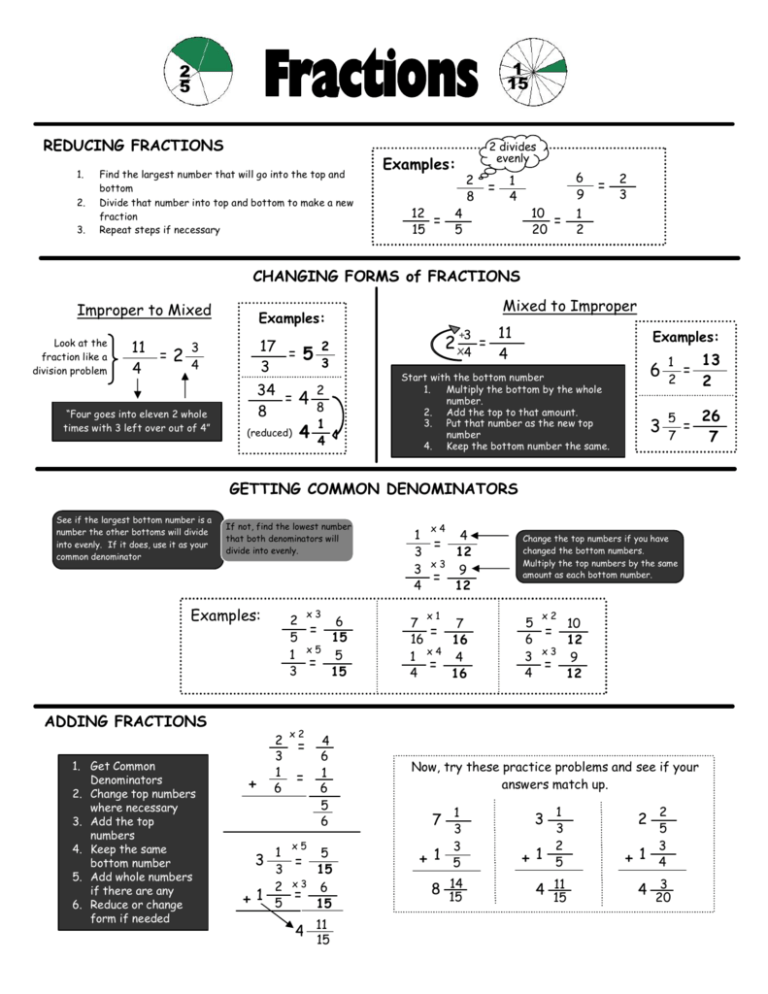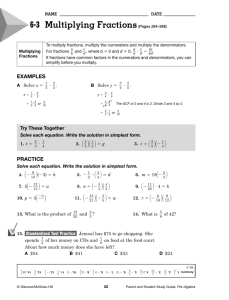Examples: = CHANGING FORMS of FRACTIONS Mixed to Improper
advertisement

1 15 2 5 REDUCING FRACTIONS 1. 2. 3. Find the largest number that will go into the top and bottom Divide that number into top and bottom to make a new fraction Repeat steps if necessary 2 divides evenly Examples: 2 8 12 = 15 6 9 = 1 4 10 = 20 4 5 = 2 3 1 2 CHANGING FORMS of FRACTIONS Improper to Mixed Look at the fraction like a division problem 2 17 = 5 3 3 3 11 =2 4 4 “Four goes into eleven 2 whole times with 3 left over out of 4” Mixed to Improper Examples: 2 34 = 4 8 8 (reduced) 4 1 4 +3 2 x4 = 11 4 Examples: Start with the bottom number 1. Multiply the bottom by the whole number. 2. Add the top to that amount. 3. Put that number as the new top number 4. Keep the bottom number the same. 6 13 1 = 2 2 3 26 5 = 7 7 GETTING COMMON DENOMINATORS See if the largest bottom number is a number the other bottoms will divide into evenly. If it does, use it as your common denominator If not, find the lowest number that both denominators will divide into evenly. Examples: x3 2 6 = 15 5 1 x5 5 = 3 15 ADDING FRACTIONS 1. Get Common Denominators 2. Change top numbers where necessary 3. Add the top numbers 4. Keep the same bottom number 5. Add whole numbers if there are any 6. Reduce or change form if needed + 2 3 1 6 x2 = = 4 6 1 6 5 6 x5 1 5 = 3 15 2 x3 6 1 5 = 15 3 + 4 11 15 x4 1 4 = 12 3 3 x3 9 = 4 12 x1 7 7 = 16 16 1 x4 4 = 4 16 Change the top numbers if you have changed the bottom numbers. Multiply the top numbers by the same amount as each bottom number. x2 5 10 = 6 12 3 x3 9 = 4 12 Now, try these practice problems and see if your answers match up. 1 3 3 1 5 7 + 14 8 15 3 +1 1 3 2 5 11 4 15 2 +1 2 5 3 4 3 4 20 SUBTRACTING FRACTIONS x2 1. 2. 3. 4. 5. 6. 7. 5 10 = 12 6 1 x3 3 2 4 = 12 7 6 12 8 Get Common Denominators Change top numbers where necessary Subtract the top numbers Borrow if necessary Keep the same bottom number Add whole numbers if there are any Reduce or change form if needed - Now, try these practice problems and see if your answers match up. 3 19 3 1 3 + 20 - 3 8 2 3 9 - 3 61 4 19 This is 3 what we have now 2 - 8 3 11 23 3 1 2 1 3 3 6 5 6 1 2 2 3 3 3 4 5 - 11 1 12 9 31 MULTIPLYING FRACTIONS 1. 2. 3. 4. 5. 6. Make sure both numbers are in fractional form (if whole numbers—put over 1, if mixed numbers—change to improper) Cancel if you can (reduce diagonally) Multiply the top numbers Multiply the bottom numbers Reduce if possible Change improper fractions to mixed numbers if needed. DIVIDING FRACTIONS 1. 2. 3. 4. 5. 6. 7. Make sure both numbers are in fractional form (if whole numbers—put over 1, if mixed numbers—change to improper) Flip the second fraction and change to multiplication Cancel if you can (reduce diagonally) Multiply the top numbers Multiply the bottom numbers Reduce if possible Change improper fractions to mixed numbers if needed. Now, try these practice problems and see if your answers match up. 2 x 3 3 4 1 2 x 3 5 3 = 4 2 1 x 2 3 6 = 2 3 x 4 6 3 1 x 9 2 10 21 = 16 2 1 x 2 = 11 1 1 11 12 5 x 4 6 7 1 2 = = 11 1 4 1 2 = 7 Just like multiplying but with one new step (Step 2) Now, try these practice problems and see if your answers match up. 1 ¸ 1 2 4 1 1 x 2 2 8 3 42 1 = 2 1 2 = 1 ¸ 5 3 6 6 2 ¸ 1 3 3 ¸ 1 3 8 3 1 4 1 x 3 = 8 = 8 1 1 = 1 ¸ 1 2 4 9 ¸ 10 1 2 5 = 26 1 6 = 4 1 5





